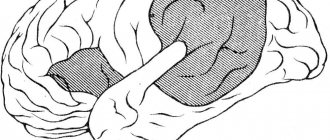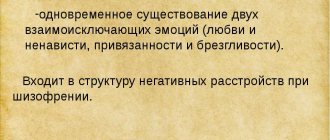Structure and functions of social conflicts
One of the most important elements of a universal conceptual scheme for describing conflicts is its structure and functions.
CONFLICT STRUCTURE. Conflict, along with the fact that it is a system
, is also
a process
.
Therefore, the structure of the conflict
is understood as a set of stable connections of the conflict, ensuring its integrity, identity with itself, difference from other phenomena of social life, without which it cannot exist as a dynamically interconnected integral system and process. The main components of the conflict structure are presented in Fig. 6.
Fig.6. Structure of the conflict
Before we begin to analyze the figure, it should be noted that in addition to the concept of “conflict,” such a concept as “conflict situation” is often used. In some cases they are considered to be equivalent, in others the differences between them are highlighted. It is obvious that a conflict situation is a particular concept in relation to conflict. A conflict situation is a fragment of a conflict, an entire episode of its development, a kind of “photographic snapshot” of the conflict at a certain point in time. Therefore, the structure of the conflict can also be considered as the structure of a conflict situation.
Analysis of Fig. 6 shows that each conflict situation has objective content and subjective (psychological) meaning. Let's consider these components of the conflict.
A. Objective content of the conflict situation:
1.Participants in the conflict.
In any social conflict, be it interpersonal or interstate conflict, the main actors are people. The degree of their participation in the conflict can be different: from direct opposition to indirect influence on the course of the conflict. Based on this, the following are identified: the main participants in the conflict (opponents); support groups; other participants.
Main participants in the conflict
. They are often called parties or opposing forces. These are those subjects of the conflict who directly carry out active (offensive or defensive) actions against each other. Some authors introduce the concept of “opponent,” which translated from Latin means “objector, opponent in a dispute” (Borodkin, Koryak, 1989).
Support groups.
Always in any conflict there are forces behind the opponents, which can be represented by individuals, groups, etc. They, either through active actions, or only by their presence and tacit support, can radically influence the development of the conflict. Even if we take into account that individual incidents during a conflict can occur one on one, without witnesses, the outcome of the conflict is largely determined by their existence.
Other participants.
This group includes subjects who have an episodic influence on the course and results of the conflict.
These are instigators and organizers (Dmitriev, Kudryavtsev, Kudryavtsev, 1993). An instigator
is a person, organization, or state that incites another party to conflict.
Organizer
- a person or group planning a conflict, various ways to provide and protect participants, etc.
2.Subject of the conflict
.
The subject of the conflict
is an objectively existing or conceivable (imaginary) problem that serves as a source of conflict between the parties; the main contradiction that gave rise to the conflict.
3.Object of conflict
.
It is not always possible to immediately identify it in every case. The problem or subject of conflict is easier to identify. The object lies deeper and is the core of the problem, the central link in the conflict situation. Therefore, sometimes it is considered as a reason, a reason for conflict. The object of the conflict
is a specific material (resource), social (power) or spiritual (idea, norm, principle) value that both opponents strive to possess or use.
4. Micro and macro environment
. When analyzing a conflict, it is necessary to highlight such an element as the conditions in which the participants in the conflict find themselves and act, i.e. the micro- and macroenvironment in which the conflict arose. This approach allows us to consider the conflict not as an isolated system, but as a social situation.
B. Psychological components of the conflict:
Important psychological components of a conflict situation are the motives, aspirations of the parties, strategy and tactics of behavior, as well as their perception of the conflict situation, i.e. those information models of the conflict that each party has and in accordance with which opponents organize their behavior in the conflict.
1. Motives of the parties.
Motives in conflict are incentives to enter into conflict related to meeting the needs of the opponent, a set of external and internal conditions that cause conflict activity of the subject. In a conflict, it is often difficult to identify the true motives of opponents, since in most cases they hide them, presenting in their positions and declared goals a motivation for participating in the conflict, which differs from the primary motives.
The motives of the opposing parties are specified in their goals
. The main goal of the opponent is to master the object of the conflict; tactical goals are subordinated to it.
The last element, the most visible part of the aspirations of a person, a social group in a conflict, which is usually analyzed and taken into account, is the position
. This is a system of the opponent’s relations to the elements of a conflict situation, manifested in appropriate behavior and actions.
2. Conflict behavior
consists of oppositely directed actions of the parties to the conflict. The alternation of mutual reactions aimed at realizing the interests of each side and limiting the interests of the opponent constitutes the visible social reality of the conflict.
Strategy
behavior in conflict is considered as the orientation of an individual (group) in relation to the conflict, an orientation toward certain forms of behavior in a conflict situation.
Strategies in conflict are implemented through various tactics. Tactics
(from the Greek tasso - lining up troops) is a set of techniques for influencing an opponent, a means of implementing a strategy. The same tactics can be used within different strategies. Thus, for example, threat or pressure, considered destructive actions, can be used in the event of the unwillingness or inability of one of the parties to concede beyond certain limits.
There are hard, neutral and soft tactics. In conflicts, the use of tactics usually goes from soft to hard.
3. Information models of conflict situations.
In another way, this subjective component of a conflict situation is called the perception of the conflict by opponents. It is extremely important for understanding the emergence and development of conflict.
The presented conflict structure is the most successful in the psychology of conflict. At the same time, a final unified understanding by psychologists of the structure of conflict does not yet exist. The topic of conflict functions seems no less problematic at present.
FUNCTIONS OF CONFLICTS. Systemic-functional analysis of conflicts shows that they play a role in relation to the participants and the social environment. This influence is multi-valued and can be considered as the functionality of the conflict.
The conflict is functional in the sense that the social and psychological processes of its development affect both the psyche, behavior, and activities of opponents and those around them.
In everyday life, people have developed an unambiguous attitude towards conflicts as negative phenomena. The occurrence of a conflict in a workshop or department, in the family or among friends is considered a symptom of trouble, and the efforts of the parties concerned are directed towards overcoming it. Those who recognize conflict as an undesirable phenomenon consider it a destroyer of a normally functioning social system. Another scientific tradition views conflict as a necessary component of social relations. This point of view is present in the works of Aristotle, Hobbes, Hegel, Weber, Marx, Coser, Dahrendorf.
The presence of opposing points of view on the role of conflicts in the life of individuals and groups at various levels has also been observed throughout the study of conflicts by domestic specialists.
Based on the above, the main functions of the conflict can be combined into a block of constructive and a block of destructive functions.
Among the design features
conflict in relation to the main participants, the following can be distinguished.
1. Conflict eliminates, in whole or in part, the contradiction that arises due to imperfect organization of activities, management errors, negligence of individual workers, etc. It highlights bottlenecks, facts of insufficient efficiency and decency. When conflicts are completed, in more than 75% of cases it is possible to completely, mainly or partially resolve the contradictions underlying them.
2. Conflict makes it possible to more deeply evaluate the individual psychological characteristics of the people involved in it. Conflict tests a person’s value orientations, the relative strength of his motives aimed at activity, at himself or at relationships, and reveals psychological resistance to the stress factors of a difficult situation.
3. Conflict allows you to ease mental tension, which is the reaction of participants to a conflict situation. Conflict interaction, especially accompanied by emotional violent reactions, in addition to possible negative consequences, relieves a person’s emotional tension and leads to a subsequent decrease in the intensity of negative emotions.
4. Conflict is a source of personality development and interpersonal relationships. Conflict, when resolved constructively, allows a person to expand the ways of interacting with others. The individual gains social experience in solving difficult situations.
5. Conflict can improve the quality of individual performance.
6. When defending fair goals in a conflict, the opponent increases his authority among others.
7. Interpersonal conflicts, being a reflection of the contradictions of the socialization process, serve as one of the means of self-affirmation of the individual, the formation of his active position in interaction with others and can be defined as conflicts of formation, self-affirmation, socialization (Pervysheva, 1990).
In addition to constructive functions, conflict, as a rule, also has destructive consequences.
.
1. Most conflicts have a pronounced negative impact on the mental state of its participants.
2. Conflicts that develop unfavorably can be accompanied by psychological and physical violence, and therefore traumatize opponents.
3. Conflict as a difficult situation is always accompanied by stress. With frequent and emotionally intense conflicts, the likelihood of cardiovascular diseases, as well as chronic disorders of the functioning of the gastrointestinal tract, sharply increases (Ivanov, 1965; Sudakov, 1974).
4. Conflict is the destruction of the system of interpersonal relationships that have developed between the subjects of interaction before it begins. Emerging hostility toward the other side, hostility, and hatred disrupt the mutual ties that had developed before the conflict. Sometimes, as a result of conflict, the relationship between the participants ends altogether.
5. Conflict forms a negative image of the other - the “image of the enemy”, which, in turn, contributes to the formation of a negative attitude towards the opponent.
6. Conflicts can negatively affect the effectiveness of individual activities of opponents.
7. Conflict reinforces violent ways of solving problems in the social experience of individuals and groups. Having once won through violence, a person reproduces this experience in other similar situations of social interaction.
8. Conflicts often have a negative impact on personal development.
Interpersonal conflict
This type occurs in case of disagreements and clashes between individuals. Among its features, it can be noted that it proceeds according to the “here and now” principle, can have both objective and subjective reasons, and is also, as a rule, characterized by high emotionality of the parties involved. The interpersonal type can also be divided into separate types of conflicts.
For example, depending on the specifics of the subordination relationship between the participants, interpersonal conflicts can be divided into “vertical”, “horizontal”, and “diagonal” conflicts. In the first case, we are dealing with subordination relationships, for example, manager - employee, teacher - student. The second case occurs when the parties to the conflict occupy equal positions and do not obey each other - work colleagues, spouses, random passers-by, people in line, etc. Diagonal conflicts can arise between opponents who are indirectly subordinate - between the boss service and the duty officer in the unit, between the senior and the junior, etc. (when the participants are in positions of different levels, but do not have a subordinate relationship with each other).
Also, interpersonal conflicts can include such types as family (marital, child-parent, conflict between brothers and sisters), domestic, conflict in an organization (we see an example of organizational conflict whenever a clash occurs in a particular production structure between its subjects within the framework of working interaction), etc.







